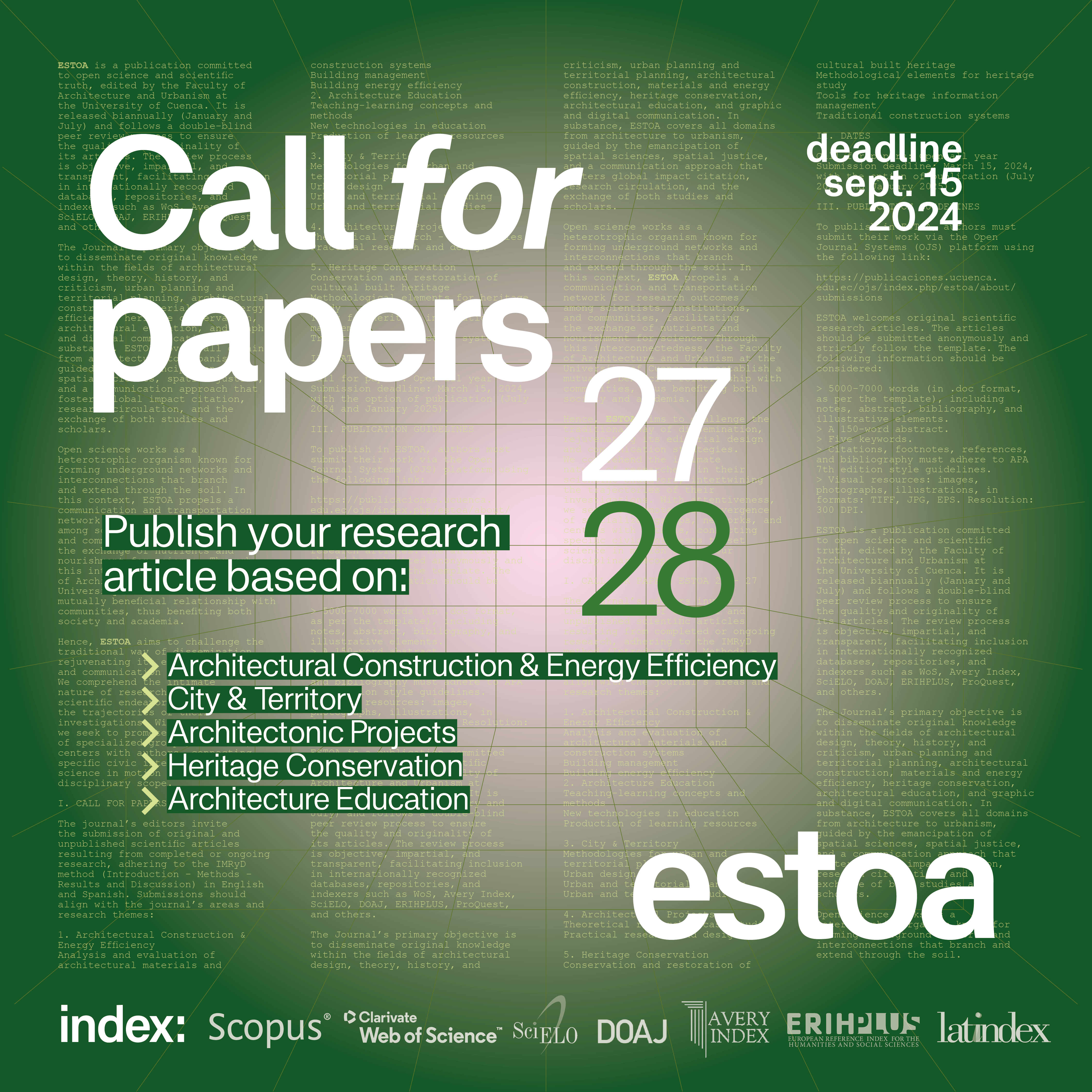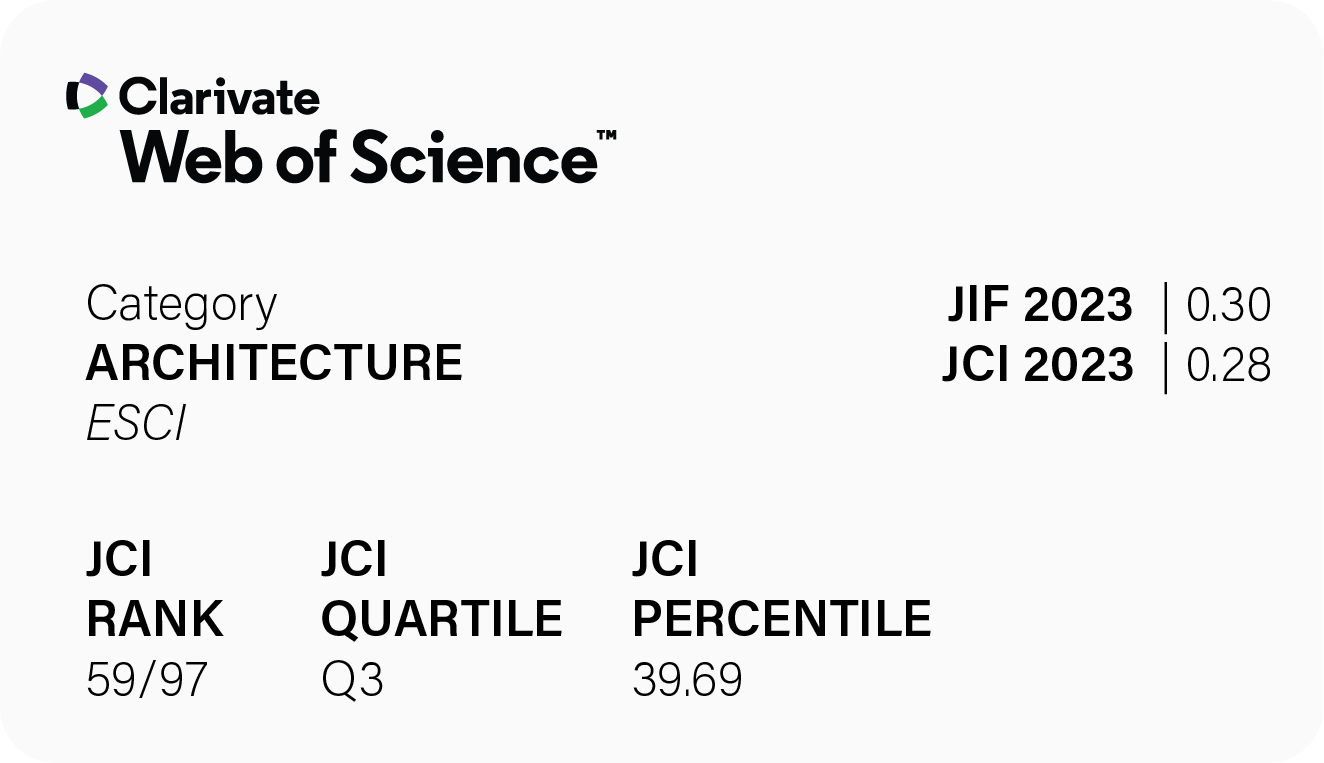Call for Papers
ESTOA is a publication committed to open science and scientific truth, edited by the Faculty of Architecture and Urbanism at the University of Cuenca. It is released biannually (January and July) and follows a double-blind peer review process to ensure the quality and originality of its articles. The review process is objective, impartial, and transparent, facilitating inclusion in internationally recognized databases, repositories, and indexers such as WoS, Avery Index, SciELO, DOAJ, ERIHPLUS, ProQuest, and others.
The Journal's primary objective is to disseminate original knowledge within the fields of architectural design, theory, history, and criticism, urban planning and territorial planning, architectural construction, materials and energy efficiency, heritage conservation, architectural education, and graphic and digital communication. In substance, ESTOA covers all domains from architecture to urbanism, guided by the emancipation of spatial sciences, spatial justice, and a communication approach that fosters global impact citation, research circulation, and the exchange of both studies and scholars.
Open science works as a heterotrophic organism known for forming underground networks and interconnections that branch and extend through the soil. In this context, ESTOA propels a communication and transportation network for research outcomes among scientists, institutions, and communities, facilitating the exchange of nutrients and nourishment for science. Through this interconnectedness, the Faculty of Architecture and Urbanism at the University of Cuenca can establish a mutually beneficial relationship with communities, thus benefiting both society and academia.
Hence, ESTOA aims to challenge the traditional way of dissemination, rejuvenating its editorial design and communication strategies. We comprehend the intimate nature of researchers in their scientific endeavors, intertwining the trajectories of their investigations. With attentiveness, we seek to promote the convergence of specialized groups, networks, and centers with authors, connecting specific civic interests to set science in motion within our disciplinary scope.
I. CALL FOR PAPERS ESTOA 27 - 28
The journal's editors invite the submission of original and unpublished scientific articles resulting from completed or ongoing research, adhering to the IMRyD method (Introduction - Methods - Results and Discussion) in English and Spanish. Submissions should align with the journal's areas and research themes:
1. Architectural Construction & Energy Efficiency
Analysis and evaluation of architectural materials and construction systems
Building management
Building energy efficiency
2. Architecture Education
Teaching-learning concepts and methods
New technologies in education
Production of learning resources
3. City & Territory
Methodologies for urban and territorial planning
Urban design
Urban and territorial planning
Urban and territorial studies
4. Architectural Projects
Theoretical research - case studies
Practical research and design
5. Heritage Conservation
Conservation and restoration of cultural built heritage
Methodological elements for heritage study
Tools for heritage information management
Traditional construction systems
II. DATES
Call for papers: July 12
Submission deadline: September 15, 2024, with the option of publication in edition 27 (January 2025) or edition 28 (July 2025).
III. PUBLICATION GUIDELINES
To publish in ESTOA, authors must submit their work via the Open Journal Systems (OJS) platform using the following link:
https://publicaciones.ucuenca.edu.ec/ojs/index.php/estoa/about/submissions
ESTOA welcomes original scientific research articles. The articles should be submitted anonymously and strictly follow the template. The following information should be considered:
> 5000-7000 words (in .doc format, as per the template), including notes, abstract, bibliography, and illustrative elements.
> A 150-word abstract.
> Five keywords.
> Citations, footnotes, references, and bibliography must adhere to APA 7th edition style guidelines.
> Visual resources: images, photographs, illustrations, in formats: TIFF, JPG, EPS. Resolution: 300 DPI.




